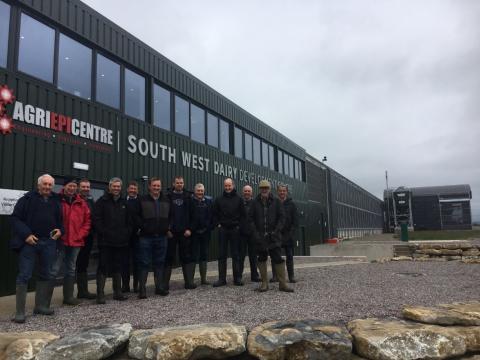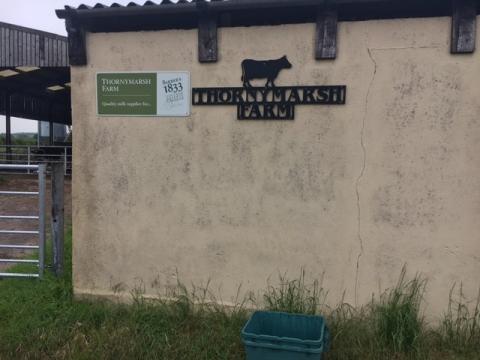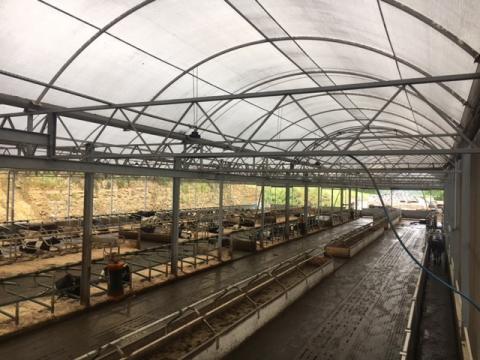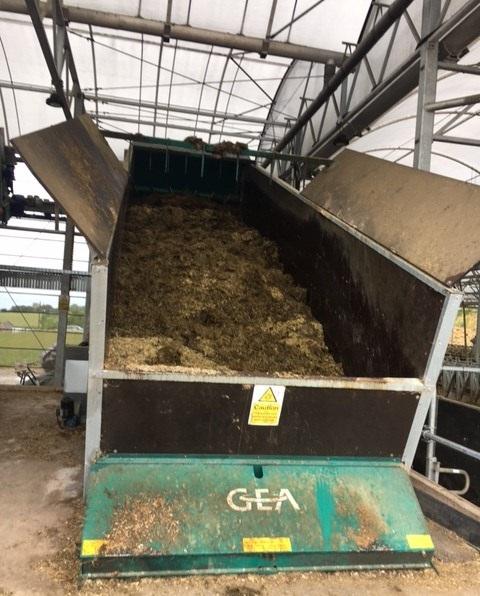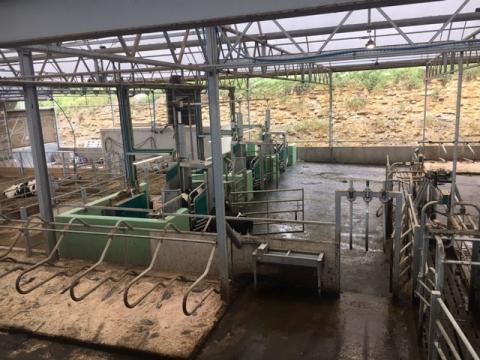Farming Connect Study Visit - Cowbois Clwyd
Cowbois Clwyd
Group visit to Somerset June 2019
10 - 11 June 2019
1) Background
Cowbois Clwyd have been meeting on a regular bi monthly basis for the past 10 years. The group are operating contrasting dairy systems from spring block calving to fully housed with robotic milking. As a group, they compare costs of production on an annual basis. The purpose of the visits were as follows:
Visiting two contrasting systems:
The latest cutting edge investments in robotic milking/feeding and data capturing technology on a commercial scale at Kingshay. Seeing the possibility of this technology on the host’s farms.
Pushing the limits of milk from forage – is 5000 litres from forage possible?
Cost control in a heavily geared business
Two farms visited over the two days.
2) Itinerary
Day 1 - John Bennett, Thornymarsh Farm, Castle Carey, Somerset, BA7 7NT trading as Dairy Decisions Ltd.
Farming 162 hectares all-grass system and milking 240 cows (flying herd) calving in two peak periods of spring and autumn. Selling milk on a solids based contract to Barbers, a local West Country cheese maker. The farm started as a 24 hectare council holding; as a tenant, they were offered the freehold of the farm as well as other neighbouring farms. Currently own 57 hectares and rent the rest.
The business carried a high debt and rent figure of 4.5 pence per litre; this demanded a focus on generating cash to repay debt.
The system was unusual in that no replacement heifers were reared and all the replacements were purchased from herds that were block calving and selling out of pattern cows. This works well in years where the margin between the replacement and the cull cow was low. All cows were served to Aberdeen Angus and calves reared to finishing.
Two main focus areas were getting the most from grass – currently at 4500 litres which is being achieved by top 10% producers and the target was 5000 litres. Grazing is on a rotational basis with weekly measuring and recording of grass and achieving the desired residuals being key.
Total costs of milk production, including rent and finance, was 26 pence which left a profit of 3.2 pence per litre.
We were interested in how to deal with the pressure debt brings on a business and how to focus on grass management, cost control, budgeting and monitoring a budget. Have a plan and be prepared to change when circumstances change. Be prepared to be challenged on your systems and practices since no one has a monopoly of ideas and solutions!
Kingshay – Agri EPI Centre Kingshay, South West Development Centre, Bridge Farm, West Bradley, Glastonbury, Somerset BA6 8LU
A dairy unit set up on a green field site in autumn 2018. Set up to promote sustainable UK milk production using the latest technology and data. Focus is on innovation, testing and demonstrating technology, maintaining high health and welfare for profitable milk production. The system is based around robotic milking and integrating this with a grazing system. The centre also provides a state-of-the-art facility for research,development and demonstration.
More UK dairy farms are changing to robotic milking, with the challenge of finding skilled labour being cited as the main reason. Robotic milking was developed for fully housed systems. With grazed grass being the cheapest feed for cows, one of the main focuses for the centre is rotationally grazing robotically milked cows. 2019 is the first year of the system and is being developed and changed as the season progresses.
Housing for the cows is in a Dutch designed and constructed building. The building is 7 metres to the eaves and covered with a fabric which is translucent and admits 20% natural light. The roof is lightweight which allows a lighter steel frame compared to standard agricultural buildings. See picture below.
Technology and data were key to what they are trying to demonstrate, with 5G being an important part.
Here are some of the key technologies being used:
A prototype 3D imaging system to measure incremental changes in cow body condition scoring, and in-line milk testing facility to measure progesterone levels in milk. This will identify oestrous status in cows.
Sensor technology – management information based on sensor technology across the farm using high speed connectivity which links data across the programme and shares with wider industry supporters.
Controlled environment – curtain walled building controlling air flow and aims to maintain an in-building temperature of 13o C. This is remotely controlled via cloud app.
Their robot system based on providing high levels of data and low cow stress.
Automated feed system (winter feeding) – the feed system delivers feed automatically to different groups of cows up to 15X per day. (See picture below of the silage being fed into the feeding box).
Picture below of the robots.
Outcome is that technology and data collection is moving on at a pace and connectivity with 5G is going to be challenging for many rural areas in Wales. With the average herd size in Wales being smaller than the rest of the UK and more dependent on family labour, there may be an attraction by some to a possible lifestyle choice when it comes to changing the milking parlour, i.e. not having the routine of having to be there to milk cows twice a day. With Wales being best suited to grass growing then a combined robotic system integrating a grazing system may be an option for some?
This will be a project worth following and see what the developments will be over the years.
3) Next Steps
Next time we meet as a group, we will have a de brief – what did each member learn and what’s to be implemented?
Some thoughts from the first visit will be to question the cash we all have tied up in capital items such as machinery. What are the potential benefits of having minimal machinery, but keeping it updated to reduce maintenance costs? Focus on budget, cash flow and monitoring the budget. Measure and question/challenge everything. Be open to outside analysis and different ideas (discussion group). Have the whole ‘team’ and family involved in the plan for the business. Focus on grass management – learn from the best and mix with them.
Herd fertility is as key as grass management to maintaining a profitable herd.
The second visit was more about the future and what is out there on the technology front and being able to use it on-farm. Technology and data will be key as well as connectivity and an aptitude for technology and interpretation of the data.

